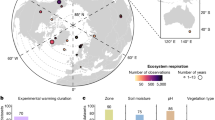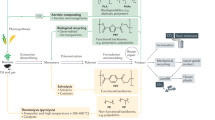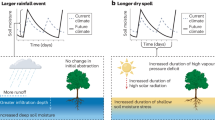Abstract
The expansion of palm oil cultivation in recent decades has led to substantial increases in greenhouse gas emissions and biodiversity loss from carbon-rich tropical forest. Because of this, there is increased focus on replacement of palm oil in industrial and consumer products. Plant oils like rapeseed and sunflower oil, exotic oils such as coconut oil and shea butter, and microbial single cell oils have been suggested as potential replacements. Here, we review each of these options from a technical, environmental and economic perspective, including the option to improve the sustainability of existing palm oil cultivation practices.
This is a preview of subscription content, access via your institution
Access options
Access Nature and 54 other Nature Portfolio journals
Get Nature+, our best-value online-access subscription
$29.99 / 30 days
cancel any time
Subscribe to this journal
Receive 12 digital issues and online access to articles
$119.00 per year
only $9.92 per issue
Buy this article
- Purchase on Springer Link
- Instant access to full article PDF
Prices may be subject to local taxes which are calculated during checkout
Similar content being viewed by others
References
OECD-FAO Agricultural Outlook 2017-2026 Special Focus: Southeast Asia (OECD/FAO, 2017).
Wicke, B., Sikkema, R., Dornburg, V. & Faaij, A. Exploring land use changes and the role of palm oil production in Indonesia and Malaysia. Land Use Policy 28, 193–206 (2011).
Fitzherbert, E. B. et al. How will oil palm expansion affect biodiversity? Trends Ecol. Evol. 23, 538–545 (2008).
Schebek, L., Mizgajski, J. T., Schaldach, R. & Wimmer, F. in From Science to Society: New Trends in Environmental Informatics (eds Otjacques, B. et al.) 49–59 (Springer, 2017).
Key World Energy Statistics 2018 (IEA, 2018).
Mba, O. I., Dumont, M.-J. & Ngadi, M. Palm oil: processing, characterisation and utilisation in the food industry - a review. Food Biosci. 10, 26–41 (2015).
Lin, S. W. in Vegetable Oils in Food Technology: Composition, Properties and Uses 2nd edn (ed. Gunstone, F. D.) 25–58 (Blackwell Publishing Ltd, 2011).
Tomkins, T. & Drackley, J. K. Applications of Palm Oil in Animal Nutrition. J. Oil Palm. Res. 22, 835–845 (2010).
Rupilius, W. & Ahmad, S. Palm oil and palm kernel oil as raw materials for basic oleochemicals and biodiesel. Eur. J. Lipid Sci. Technol. 109, 433–439 (2007).
Ratledge, C. & Cohen, Z. Microbial and algal oils: do they have a future for biodiesel or as commodity oils? Lipid Technol. 20, 155–160 (2008).
Whiffin, F., Santomauro, F. & Chuck, C. J. Toward a microbial palm oil substitute: oleaginous yeasts cultured on lignocellulose. Biofuel. Bioprod. Biorefin. 10, 316–334 (2016).
Hinrichsen, N. Commercially available alternatives to palm oil. Lipid Technol. 28, 65–67 (2016).
Food and Agriculture Data (FAOSTAT, 2017); http://www.fao.org/faostat/en/#home
Anushree, S., André, M., Guillaume, D. & Frédéric, F. Stearic sunflower oil as a sustainable and healthy alternative to palm oil. Agron. Sustain. Dev. 37, 18 (2017).
Keneni, Y. G. & Marchetti, J. M. Oil extraction from plant seeds for biodiesel production. AIMS Energy 5, 316–340 (2017).
Arvidsson, R., Persson, S., Froling, M. & Svanstrom, M. Life cycle assessment of hydrotreated vegetable oil from rape, oil palm and Jatropha. J. Clean. Prod. 19, 129–137 (2013).
Schmidt, J. H. Comparative life cycle assessment of rapeseed oil and palm oil. Int. J. Life Cycle Assess. 15, 183–197 (2010).
Schmidt, J. H. Life cycle assessment of five vegetable oils. J. Clean. Prod. 87, 130–138 (2015).
Oilcrops Complex: Policy Changes and Industry Measures – Annual Compendium (FAO, 2017); https://go.nature.com/3bdIq5n
Dufour, J. & Iribarren, D. Life cycle assessment of biodiesel production from free fatty acid-rich wastes. Renew. Energy 38, 155–162 (2012).
Esteves, V. P. P. et al. Assessment of greenhouse gases (GHG) emissions from the tallow biodiesel production chain including land use change (LUC). J. Clean. Prod. 151, 578–591 (2017).
de Guzman, D. Fat fight: Catch-22 for Western Oleochemicals? (AOCS, 2013); https://go.nature.com/31GTsMp
Airline in first biofuel flight. BBC http://news.bbc.co.uk/2/hi/7261214.stm (2008).
Silva, F. C. et al. Production of biodiesel from babassu oil using methanol-ethanol blends. Eclét. Quím. 35, 41–46 (2010).
Thapa, S., Indrawan, N. & Bhoi, P. R. An overview on fuel properties and prospects of Jatropha biodiesel as fuel for engines. Environ. Technol. Innov. 9, 210–219 (2018).
Sandouqa, A. & Al-Hamamre, Z. Energy analysis of biodiesel production from jojoba seed oil. Renew. Energy 130, 831–842 (2019).
Exporting Shea Butter for Cosmetics to Europe (CBI, 2019).
Glew, D. & Lovett, P. N. Life cycle analysis of shea butter use in cosmetics: from parklands to product, low carbon opportunities. J. Clean. Prod. 68, 73–80 (2014).
Are you invested in Exploitation? Why US Investment Firms Should Quit Financing Conflict Palm Oil and Commit to Human Rights (Friends of the Earth, 2016).
Cohen, Z. & Ratledge, C. (eds) Single Cell Oils - Microbial and Algal Oils 2nd edn (AOCS Press, 2010).
Singh, S. & Olsen, S. I. A critical review of biochemical conversion, sustainability and life cycle assessment of algal biofuels. Appl. Energy 88, 3548–3555 (2011).
Sheehan, J., Dunahay, T., Benemann, J. & Roessler, P. A Look Back at the U.S. Department of Energy’s Aquatic Species Program: Biodiesel from Algae (NREL, 1998).
Ratledge, C. Fatty acid biosynthesis in microorganisms being used for single cell oil production. Biochemie 86, 807–815 (2004).
Hicks, R., Gore-Lloyd, D., Henk, D. & Chuck, C. Adaptive evolution method for increased performance in Metchnikowia pulcherrima. GB patent P124919GB (2019).
Ykema, A., Verbree, E. C., Kater, M. M. & Smit, H. Optimization of lipid production in the oleaginous yeast Apiotrichum curvatum in whey permeate. Appl. Microbiol. Biotechnol. 28, 211–218 (1988).
Qiao, K., Wasylenko, T. M., Zhou, K., Xu, P. & Stephanopoulos, G. Lipid production in Yarrowia lipolytica is maximised by engineering cytosolic redox metabolism. Nat. Biotechnol. 35, 173–177 (2017).
Davies, R. in Single Cell Oil (ed. Moreton, R. S.) 99–146 (John Wiley & Sons, 1988).
Giam, X., Mani, L., Koh, L. P. & Tan, H. T. W. Saving tropical forests by knowing what we consume. Conserv. Lett. 9, 267–274 (2016).
Parsons, S., Chuck, C. J. & McManus, M. C. Microbial lipids: progress in life cycle assessment (LCA) and future outlook of heterotrophic algae and yeast-derived oils. J. Clean. Prod. 172, 661–672 (2018).
Quinn, J. C. & Davis, R. The potentials and challenges of algae based biofuels: a review of the techno-economic, life cycle, and resource assessment modeling. Bioresour. Technol. 184, 444–452 (2015).
Koutinas, A. A., Chatzifragkou, A., Kopsahelis, N., Papanikolaou, S. & Kookos, I. K. Design and techo-economic evaluation of microbial oil production as a renewable resource for biodiesel and oleochemical production. Fuel 116, 566–577 (2014).
Chang, K. J. L. et al. Life cycle assessment: heterotrophic cultivation of thraustochytrids for biodiesel production. J. Appl. Phycol. 27, 639–647 (2015).
Karlsson, H. et al. A systems analysis of biodiesel production from wheat straw using oleaginous yeast: process design, mass and energy balances. Biotechnol. Biofuels 9, 229 (2016).
Braunwald, T., French, W. T., Claupein, W. & Graeff-Honninger, S. Economic assessment of biodiesel production using heterotrophic yeast. Int. J. Green. Energy 13, 274–282 (2016).
Jena, U. et al. Oleaginous yeast platform for producing biofuels via co-solvent hydrothermal liquefaction. Biotechnol. Biofuels 8, 167 (2015).
Summers, H. M. et al. Techno-economic feasibility and life cycle assessment of dairy effluent to renewable diesel via hydrothermal liquefaction. Bioresour. Technol. 196, 431–440 (2015).
Parsons, S., Abeln, F., McManus, M. C. & Chuck, C. J. Techno‐economic analysis (TEA) of microbial oil production from waste resources as part of a biorefinery concept: assessment at multiple scales under uncertainty. J. Chem. Technol. Biotechnol. 94, 701–711 (2018).
Aladedunye, F. & Przybylski, R. Performance of palm olein and modified rapeseed, sunflower, and soybean oils in intermittent deep‐frying. Eur. J. Lipid Sci. Technol. 116, 144–152 (2014).
Santomauro, F., Whiffin, F., Scott, R. J. & Chuck, C. J. Low-cost lipid production by an oleaginous yeast cultured in non-sterile conditions using model waste resources. Biotechnol. Biofuels 7, 34 (2014).
Directive (EU) 2018/2001 of the European Parliament and of the Council of 11 December 2018 on the Promotion of the Use of Energy from Renewable Sources PE/48/2018/REV/1 (European Parliament, 2018).
A Global Standard For Sustainable Palm Oil (RSPO, 2019); https://rspo.org/certification
Oosterveer, P., Adjei, B. E., Vellema, S. & Slingerland, M. Global sustainability standards and food security: exploring unintended effects of voluntary certification in palm oil. Glob. Food Secur. 3, 220–226 (2014).
Ruysschaert, D. & Salles, D. Towards global voluntary standards: questioning the effectiveness in attaining conservation goals: the case of the Roundtable on Sustainable Palm Oil (RSPO). Ecol. Econ. 107, 438–446 (2014).
Principles and Criteria for the Production of Sustainable Palm Oil (RSPO, 2018).
Adoption of RSPO Independent Smallholder Standard at the 16th Annual General Assembly (RSPO, 2019); https://go.nature.com/2Uz85zB
Wilman, E. A. Market redirection leakage in the palm oil market. Ecol. Econ. 159, 226–234 (2019).
Lyons-White, J. & Knight, A. T. Palm oil supply chain complexity impedes implimentation of corporate no-deforestation commitments. Glob. Environ. Change 50, 303–313 (2018).
Wiloso, E. I., Bessou, C. & Heijungs, R. Methodological issues in comparative life cycle assessment: treatment options for empty fruit bunches in a palm oil system. Int. J. Life Cycle Assess. 20, 204–216 (2015).
Neste-lead Project Verified 50% Methane Emission Reduction at Palm Oil Mills (Neste, 2018); https://go.nature.com/2H0OCzU
Oilseeds: World Markets and Trade (USDA Foreign Agricultural Service, 2019).
Murphy, D. J. The Status of Industrial Vegetable Oils from Genetically Modified Plants (European Chemicals Agency, 2012).
Kostik, V., Memeti, S. & Bauer, B. Fatty acid composition of edible oils and fats. J. Hyg. Eng. Des. 4, 112–116 (2013).
Orsavova, J., Misurcova, L., Ambrozova, J., Vicha, R. & Mlcek, J. Fatty acids composition of vegetable oils and its contribution to dietary energy intake and dependence of cardiovascular mortality on dietary intake of fatty acids. Int. J. Mol. Sci. 16, 12871–12890 (2015).
Jackson, F. L. & Longenecker, H. E. The fatty acids and glycerides of babassu oil. Oil Soap 21, 73–75 (1944).
El Bassam, N. Handbook of Bioenergy Crops: A Complete Reference to Species, Development and Applications (Routledge, 2010).
Aboubakar, X., Goudoum, A., Bébé, Y. & Mbofung, C. Optimization of Jatropha curcas pure vegetable oil production parameters for cooking energy. S. Afr. J. Chem. Eng. 24, 196–212 (2017).
Akbar, E., Yaakob, Z., Kamarudin, S. K., Ismail, M. & Salimon, J. Characteristic and composition of Jatropha curcas oil seed from Malaysia and its potential as biodiesel feedstock feedstock. Eur. J. Sci. Res. 29, 396–403 (2009).
Lam, M. K., Lee, K. T. & Mohamed, A. R. Life cycle assessment for the production of biodiesel: A case study in Malaysia for palm oil versus jatropha oil. Biofuels Bioprod. Biorefin. 3, 601–612 (2009).
Lipp, M. & Anklam, E. Review of cocoa butter and alternative fats for use in chocolate—Part A. Compositional data. Food Chem. 62, 73–97 (1998).
ul Hassan, Z. et al. in Oilseed Crops: Yield and Adaptations under Environmental Stress (ed. Ahmad, P.) 236–248 (John Wiley & Sons, 2017).
Nayak, S. K. & Mishra, P. C. Investigation on jojoba biodiesel and producer gas in dual-fuel mode. Energy Sources A: Recov. Util. Environ. Eff. 38, 2265–2271 (2016).
Addison, K. Oil Yields and Characteristics http://journeytoforever.org/biodiesel_yield.html (2001).
Gunstone, F. D. Fatty Acid and Lipid Chemistry 61–86 (Springer, 1996).
Sander, K. & Murthy, G. S. Life cycle analysis of algae biofuels. Int. J. Life Cycle Assess. 15, 704–714 (2010).
Borowitzka, M. A. & Borowitzka, L. J. Micro-algal Biotechnology (Cambridge Univ. Press, 1988).
Abeln, F. & Chuck, C. J. Achieving a high-density oleaginous yeast culture: comparison of four processing strategies using Metschnikowia pulcherrima. Biotechnol. Bioeng. 116, 3200–3214 (2019).
Thevenieau, F. & Nicaud, J.-M. Microorganisms as sources of oils. OCL 20, D603 (2013).
Acknowledgements
This research has been funded by the Industrial Biotechnology Catalyst (Innovate UK, BBSRC, EPSRC) (EP/N013522/1).
Author information
Authors and Affiliations
Contributions
S.P. and C.J.C. conceived the initial idea, and developed the structure and concepts of the Perspective. S.P. and S.R. contributed to writing and researching the initial outline, with all authors involved in further content development and revisions. C.J.C. was awarded the initial funding.
Corresponding authors
Ethics declarations
Competing interests
The authors declare no competing interests.
Additional information
Publisher’s note Springer Nature remains neutral with regard to jurisdictional claims in published maps and institutional affiliations.
Rights and permissions
About this article
Cite this article
Parsons, S., Raikova, S. & Chuck, C.J. The viability and desirability of replacing palm oil. Nat Sustain 3, 412–418 (2020). https://doi.org/10.1038/s41893-020-0487-8
Received:
Accepted:
Published:
Issue Date:
DOI: https://doi.org/10.1038/s41893-020-0487-8
This article is cited by
-
Equilibrium, Thermodynamic and Kinetic Studies of Palm Oil β-carotene Adsorption by Composites Based Silica-Smectite
Chemistry Africa (2024)
-
Mastering targeted genome engineering of GC-rich oleaginous yeast for tailored plant oil alternatives for the food and chemical sector
Microbial Cell Factories (2023)
-
Enhancing the ecological value of oil palm agriculture through set-asides
Nature Sustainability (2023)
-
Reconciling oil palm and ecosystems
Nature Sustainability (2023)
-
Aiding food security and sustainability efforts through graph neural network-based consumer food ingredient detection and substitution
Scientific Reports (2023)



